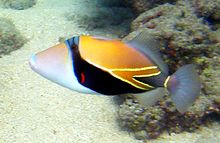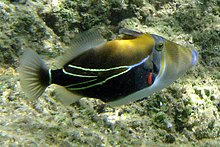Reef triggerfish
- "Humuhumunukunukuāpuaa" redirects here. For the Rhinecanthus aculeatus of the same name, see Lagoon triggerfish. For the High School Musical 2 song, see High School Musical 2 (soundtrack).
| Reef Triggerfish | |
|---|---|

| |

| |
| Scientific classification | |
| Kingdom: | |
| Phylum: | |
| Class: | |
| Order: | |
| Family: | |
| Genus: | |
| Species: | R. rectangulus
|
| Binomial name | |
| Rhinecanthus rectangulus | |
The reef, rectangular, or wedge-tail triggerfish, also known by its Hawaiian name, humuhumunukunukuāpuaʻa (pronounced [ˈhumuˈhumuˈnukuˈnukuˈwaːpuˈwɐʔə]), also spelled Humuhumunukunukuapua'a or just humuhumu for short; meaning "fish that grunts like a pig" for the sound it makes when cornered or caught.[1] [2] [3], is one of several species of triggerfish. Classified as Rhinecanthus rectangulus, it is endemic to the salt water coasts of various central and south Pacific Ocean islands. It is often asserted that the Hawaiian name is one of the longest words in the Hawaiian language and that "the name is longer than the fish."
Description
The triggerfish's teeth and top lip are blue and the teeth are set close together inside its relatively chubby mouth, it has a small second spine, which it can use to lock its main spine into an upright position. The triggerfish can wedge itself into small crevices and lock its spine to make it extremely difficult to get out. In addition, when fleeing from predators, the triggerfish will sometimes make grunting noises, possibly a call to warn other nearby triggerfish of danger that is about to be encountered. [4]
One particularly interesting aspect of the fish's behavior is the ability to blow jets of water from its mouth. These jets help the fish find benthic invertebrates that may be buried under the substrate. Triggerfish can often be seen spitting sand from their mouths in order to sift through the material in search of edible detritus or organisms. Reef triggers are fairly aggressive and will generally not tolerate conspecific species in its general vicinity, thus the fish is often found solitary. This is particularly true in captivity. Triggers have the remarkable ability to rapidly alter their coloration. They can fade into a relatively drab appearance when sleeping or demonstrating submission while the coloration is often the most vivid when the fish is healthy and unthreatened by its surrounding.
Distribution
The reef triggerfish is distributed throughout the Indo-Pacific region, and it is especially prominent in the coral reefs of the Hawaiian Islands.
Hawaii state fish

The reef triggerfish was originally designated the official fish of Hawaii in 1985,[5] but due to an expiration of a Hawaiian state law after five years, it ceased to be the state fish in 1990.[6] On April 17, 2006, bill HB1982 was presented to the Governor of Hawaiʻi which permanently reinstated the reef triggerfish (humuhumunukunukuapuaʻa) as the state fish of Hawaiʻi.[7] The bill passed into law on May 2, 2006 and was effective upon its approval.[8][9]
In Popular Culture
The 1933 popular song "My Little Grass Shack in Kealakekua, Hawaii" included the Hawaiian name in its refrain, and a song of this title was included in the film High School Musical 2.
The fish's name was also included in a scene from the movie Forgetting Sarah Marshall, although pronounced slightly wrong by the actor.
The species also features in an episode of the animated underwater children's TV series The Octonauts, where the characters repeatedly learn how to pronounce its Hawaiian name.
Bugs Bunny uses the fish's name in "Wackiki Wabbit" to heckle a pair of starving castaways intent on catching him.
Status as the Longest Fish Name
Humuhumunukunukuapuaʻa means "triggerfish with a pig-like short snout". It is not, as often claimed, the longest fish name in Hawaiian; that distinction belongs to lauwiliwilinukunukuʻoiʻoi ("long-snouted fish shaped like a wiliwili leaf"), the butterflyfish Forcipiger longirostris.
Notes
- ^ The Virtual Terrain Project.
- ^ http://www.kidzworld.com/article/157-travel-the-islands-of-hawaii
- ^ http://waikikiswimclub.org/history.htm
- ^ http://www.waquarium.org/_library/images/education/marinelifeprofiles/reeftrigger0909.pdf
- ^ Hawaiian Bill 1982 Retrieved 2011-05-17
- ^ "Lawmaker seeks official status for humuhumunukunukuapuaa". USA Today. January 1, 2006. Retrieved May 22, 2010.
- ^ HB1982 Measure History
- ^ House Bill
- ^ Hawaii may honor long-named fish - Weird news - MSNBC.com
References
- "Rhinecanthus rectangulus". Integrated Taxonomic Information System. Retrieved 30 January 2006.
- "Marine Life Profile: Reef Triggerfish" (PDF). Waikiki Aquarium. Retrieved 24 November 2011.
- Froese, Rainer; Pauly, Daniel (eds.) (2005). "Rhinecanthus rectangulus" in FishBase. December 2005 version.
- "Legislation to permanently establish as Hawaii state fish". Archived from the original on 10 July 2006. Retrieved 28 January 2006.
- "Hawaii may honor fish with long name". Retrieved 18 April 2006.
